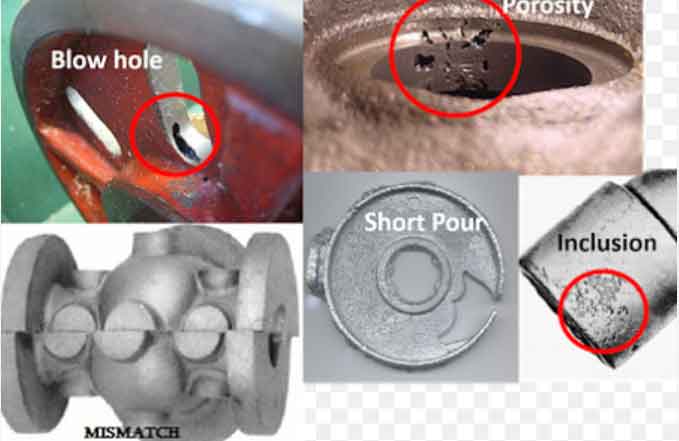
Casting defects can have a significant impact on the quality and functionality of castings. Understanding the causes, types, and appropriate solutions for these defects is essential for producing high-quality castings. This article provides an overview of common casting defects, their causes, and effective solutions to ensure high-quality castings.
- Porosity:
- Causes: Porosity can occur due to various factors, including gas entrapment during solidification, improper gating and venting, high moisture content in molds or cores, or inadequate melt treatment.
- Solutions: Improve gating and venting design to allow for proper gas escape, ensure proper moisture content control in molds and cores, optimize melt treatment processes to minimize gas content, and use suitable fluxes or degassing agents to reduce gas porosity.
- Shrinkage:
- Causes: Shrinkage defects result from inadequate feeding of the casting during solidification, typically due to insufficient riser design or improper feeding system.
- Solutions: Optimize riser design to provide proper feeding, ensure adequate riser size and placement, use exothermic or insulating sleeves to maintain solidification temperature, and employ feeding aids such as chills or feeders to promote directional solidification.
- Cold Shut:
- Causes: Cold shuts occur when two or more streams of molten metal do not fuse together properly during filling, resulting in a visible line or seam on the casting surface.
- Solutions: Optimize gating and runner design to promote proper metal flow and fusion, control pouring parameters to ensure uniform metal filling, and use proper mold materials and coatings to minimize metal chilling.
- Misrun:
- Causes: Misruns happen when the molten metal fails to completely fill the mold cavity, resulting in an incomplete casting.
- Solutions: Optimize gating system design to ensure proper metal flow and fill the mold, increase pouring temperature or rate if necessary, modify mold design to improve venting and reduce resistance to metal flow.
- Surface Defects:
- Causes: Surface defects can include rough surfaces, sand inclusions, metal penetration, or mold erosion, which may arise from inadequate mold or core coatings, improper gating or venting, or poor mold quality.
- Solutions: Use appropriate mold and core coatings to promote good surface finish, ensure proper gating and venting for smooth metal flow, employ suitable mold materials or coatings to resist erosion, and maintain high-quality molds through regular maintenance.
- Inclusions:
- Causes: Inclusions occur when foreign materials, such as oxides, slag, or sand, get trapped in the casting during the pouring process.
- Solutions: Control melt cleanliness through proper melt treatment, minimize exposure to contaminants during handling and storage of raw materials, employ effective filtration techniques, and use appropriate fluxes or refining agents to remove impurities.
Casting defects can significantly impact the quality and performance of castings. By understanding the causes, types, and appropriate solutions for casting defects such as porosity, shrinkage, cold shut, misrun, surface defects, and inclusions, manufacturers can take proactive measures to produce high-quality castings. Through proper process optimization, material control, mold design, and quality assurance practices, casting defects can be minimized, resulting in consistent and reliable high-quality castings. Continuous improvement, regular defect analysis, and a focus on preventive measures will further enhance casting quality and customer satisfaction.
